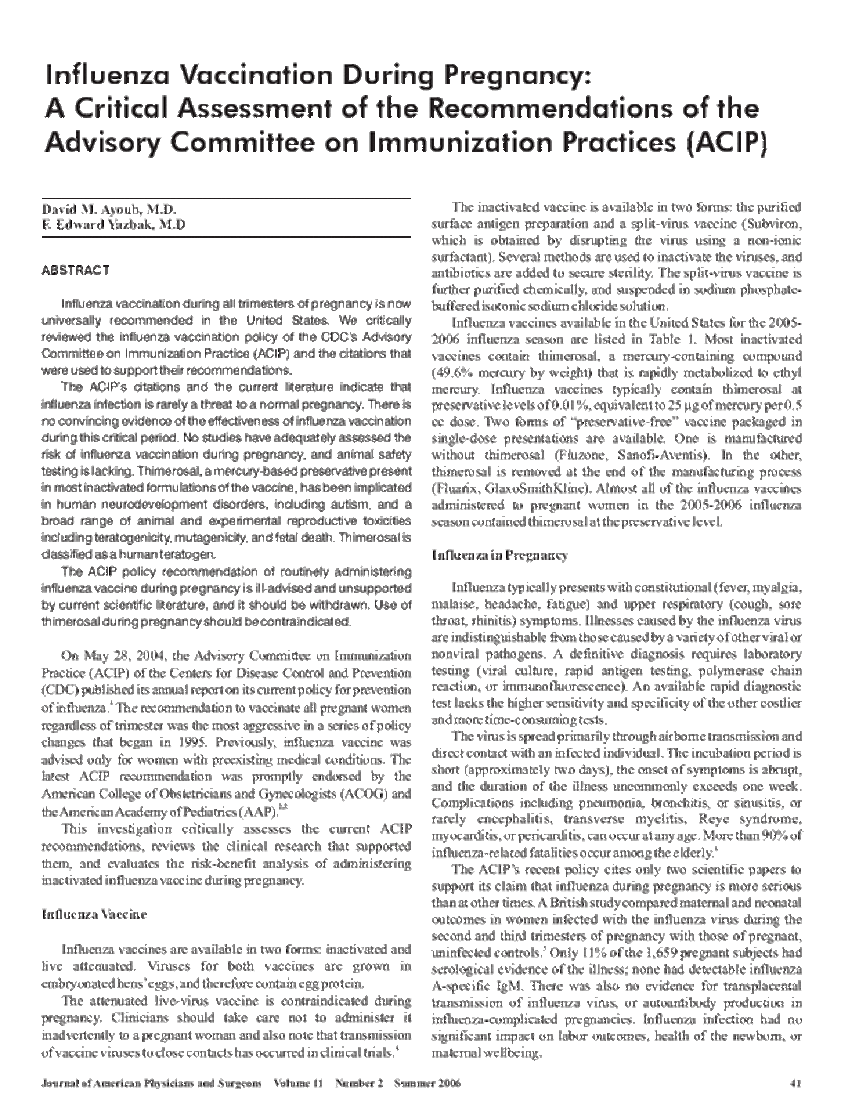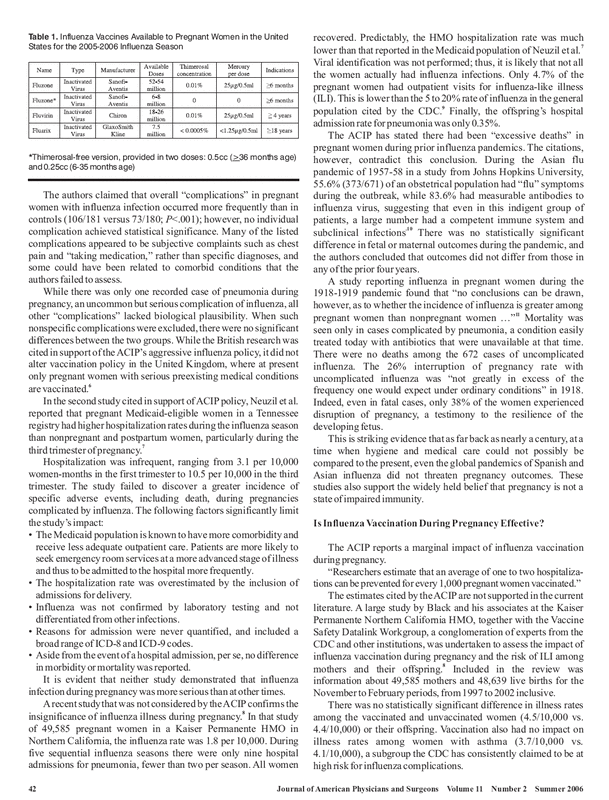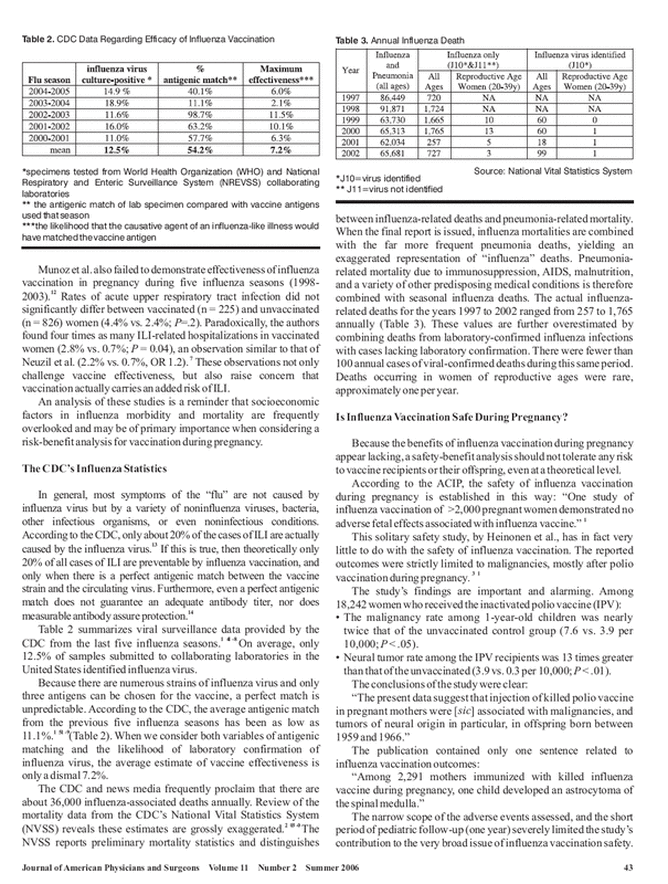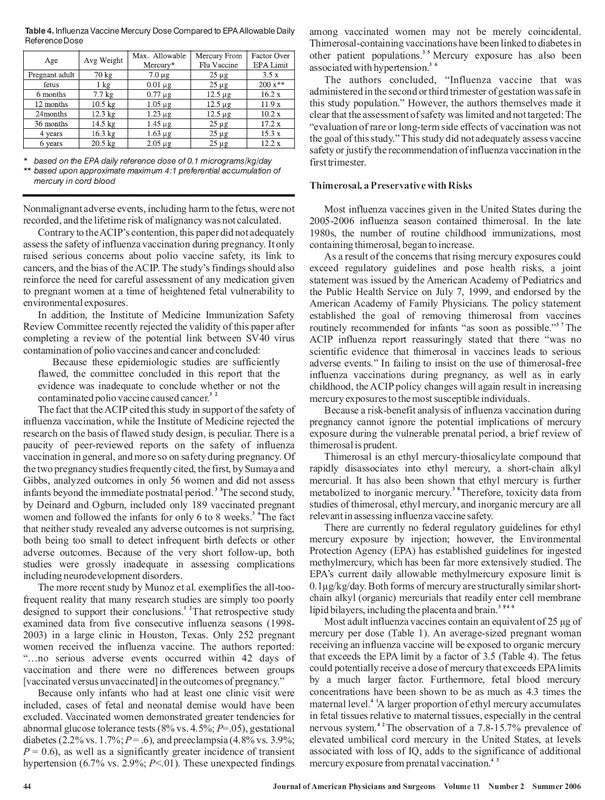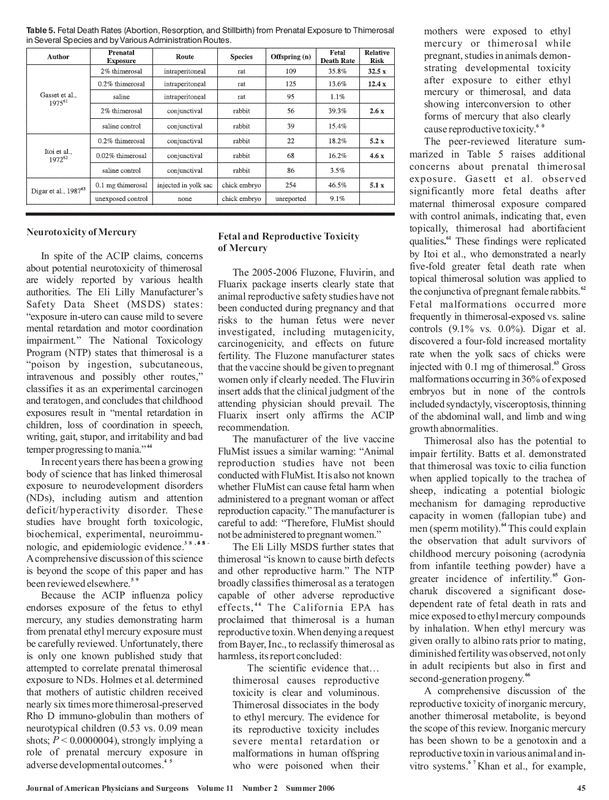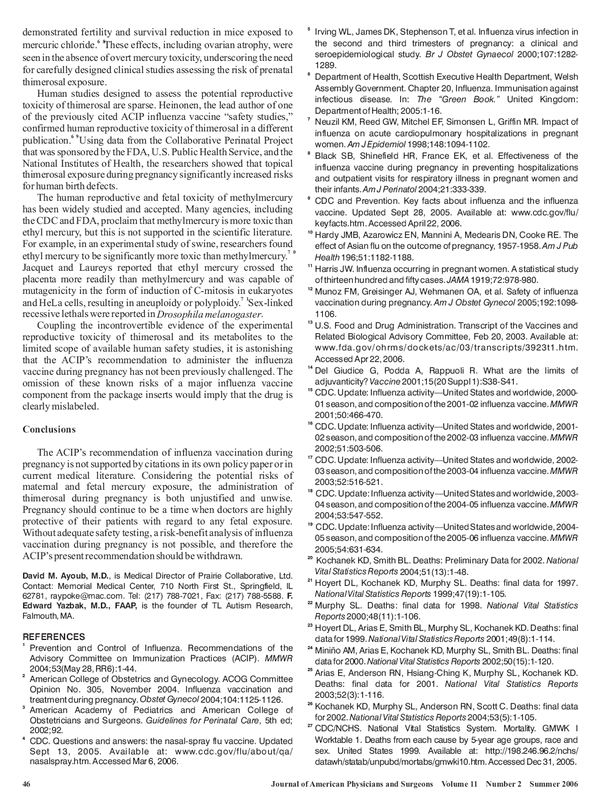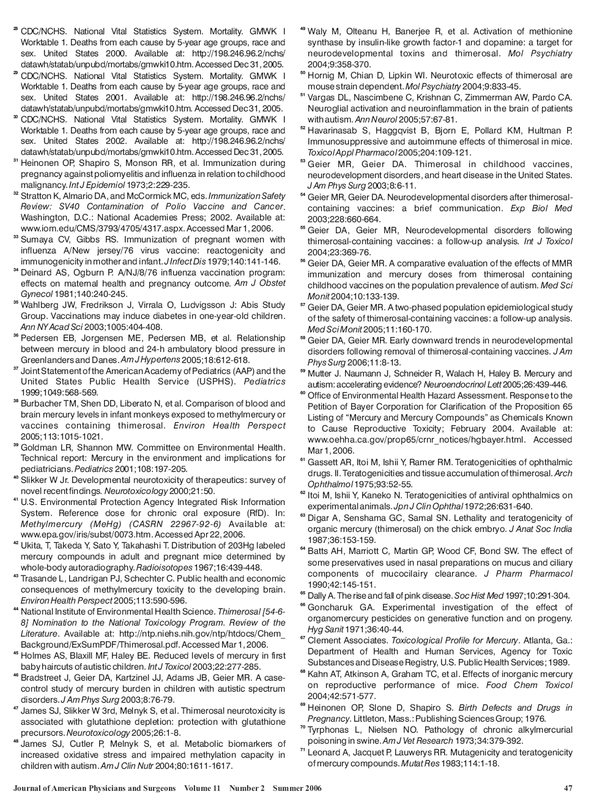October 8, 1999
Flu Vaccine: Stay Out of My Womb!
Commentary by Dawn Richardson
Pregnant women everywhere know the feeling of making it to the milestone of their second trimester. For most, queasiness starts to subside, energy returns in spurts, and of course there is that indescribable feeling of becoming aware of your developing baby's movements.
You've altered your diet, exercised, stayed away from over the counter medications, your true hair color is revealing itself, and that wonderful bottle of wine with the Surgeon General's warning will continue stay buried in the back of the refrigerator awaiting the skinnier days ahead.
You ask yourself, "Is there anything more that I can do for me and my baby during the remainder of my pregnancy?" Well, according to the Centers for Disease Control (CDC) and the federal government's Advisory Committee on Immunization Practices (ACIP) there is - get the flu vaccine before this year's flu season hits. According to the CDC and ACIP, it was estimated that an average of 1 to 2 hospitalizations among pregnant women could be prevented for every 1,000 pregnant women immunized. (Prevention and Control of Influenza: Recommendations of ACIP. MMWR - May 1, 1998; 47)
My initial pregnant maternally protective hormonal response to this was utter disbelief. How could a biological pharmaceutical product be recommended for routine use for all healthy second and third trimester pregnant women? As I looked into this further, I became outraged and inspired to share the truth with pregnant women so they could make up their own minds. Here is what I found.
There are four drug manufacturers for this year's flu vaccine. The product package inserts published by the manufacturers state the disclaimer that "Animal reproduction studies have not been conducted with influenza virus vaccine. It is also not known whether influenza virus vaccine can cause fetal harm when administered to a pregnant woman...Although animal reproductive studies have not been conducted, the prescribing health-care provider should be aware of the recommendations of the Advisory Committee on Immunization Practices...The ACIP states that, if used during pregnancy, administration of influenza virus vaccine after 14 weeks of gestation may be preferable to avoid coincidental association of the vaccine with early pregnancy loss..."
Additional reading and phone calls to the manufacturers confirmed that all four flu vaccines contain thimerosal, a mercury derivative preservative banned by the Food and Drug Administration (FDA) in over-the-counter (OTC) drug preparations because of questions over safety. (Federal Register: April 22, 1998 (Volume 63, Number 77)][Page 19799-19802].
On July 7, 1999, the American Academy of Pediatrics (AAP) and the United States Public Health Service (PHS) issued a joint statement that because of the "neuro-developmental effects posed by exposure to thimerosal", "thimerosal-containing vaccines should be removed as soon as possible." The PHS and AAP recognized that because of thimerosal in vaccines, some children would be exposed to "a cumulative level of mercury over the first six months of life that exceeds one of the federal guidelines on methyl mercury." Hospitals around the country responded this summer by halting the administration of the thimerosal containing vaccine for hepatitis B at birth, deferring vaccination until the baby is older and more developed. What about my beloved little baby that isn't even developed enough to live outside the womb yet?
A quick internet search showed that even the CDC, in a revealing self-contradiction at another location, posted: "Q. Who is most vulnerable to mercury? A. Two groups are most vulnerable to methyl mercury: the fetus and children ages 14 and younger."
(http://www.cdc.gov/nip/Q&A/genqa/Thimerosal.htm) More searching on the National Library of Medicine site almost effortlessly produced hundreds of articles and studies in medical and scientific journals clearly documenting the damaging effects of prenatal exposure to mercury. The results of one recent study published in the August 1, 1999 issue of the American Journal of Epidemiology stated that "the greatest susceptibility to methylmercury neurotoxicity occurs during late gestation, while early postnatal vulnerability is less" which is the precise point in time that ACIP and the CDC is recommending we get the shot.
I then decided to call the CDC's Influenza Division myself, as a pregnant mother baffled by this scientifically unfounded and potentially unsafe recommendation. Maybe I was missing something that an "expert" could reveal for me. I was told that there was no scientific proof that the flu vaccine caused fetal harm. Well of course not, the manufacturers are right up front when they state that this hasn't been studied - isn't that convenient. I was also told that the CDC had no intention to change the recommendation for pregnant women because of thimerosal. The doctor blamed the recent concerns on "politics" rather than science. What a shame.
Even though the CDC does claim that a single study of a small number of pregnant women have demonstrated no adverse fetal effects associated with influenza vaccine; they continue and say, "however, more data are needed." Maybe this scientifically unsubstantiated recommendation is how the CDC plans on getting that data. So much for the Nazi war criminal trials at Nuremberg outlawing human experimentation without informed consent.
While I would absolutely hate to be one of the 1 in 1000 pregnant women needing to go to the hospital for the flu this winter, at this point, I feel far more threatened by the public health bureaucrats recklessly willing to experiment on me and my unborn child with a flu vaccine not proven safe for my baby. To receive email updates on vaccine safety and informed consent issues,
write to prove@vaccineinfo.net
Permission to distribute and print in whole and unedited given by,
Dawn Richardson
President, PROVE (Parents Requesting Open Vaccine Education)
prove@vaccineinfo.net (email)
http://vaccineinfo.net (web site)
http://www.medicalnewstoday.com/?newsid=16045#
6% US Women of Childbearing Age Have Worrying Mercury Levels
08 Nov 2004
About 6% of U.S. women of childbearing age have blood mercury levels high enough to harm a developing fetus, according to a study published in the Nov. 5 issue of CDC's Morbidity and Mortality Weekly Report, the Atlanta Journal-Constitution reports (Wahlberg, Atlanta Journal-Constitution, 11/4).
Mercury accumulates in the environment, in the flesh of fish and in the bodies of humans and other animals that eat fish. High levels of mercury in pregnant women and women of childbearing age have been shown to contribute to birth defects, and several studies have demonstrated a subtle loss of mental acuity in the offspring of women who consume fish during pregnancy.
As a result, FDA and the Environmental Protection Agency have released guidelines recommending that women of childbearing age, pregnant women, women who are nursing and young children limit their intake of certain types of fish that have been found to have high mercury content (Kaiser Daily Reproductive Health Report, 10/22).
CDC researchers studied blood samples taken from more than 3,600 women ages 16 to 49 between 1999 and 2002. Among the women studied, 8% had unsafe blood mercury levels in 1999-2000, compared with 4% in 2001-2002. However, CDC said the recorded decline between 1999-2000 and 2001-2002 could be a sampling error and cited 6% as the "best estimate" of the percentage of U.S. women of childbearing age who have unsafe blood mercury levels (Atlanta Journal-Constitution, 11/4).
Last month, the interim results of a nationwide study commissioned by the environmental advocacy group Greenpeace showed that about 20% of women of childbearing age in the United States have blood mercury levels that exceed government-recommended guidelines (Kaiser Daily Reproductive Health Report, 10/22).
Robert Jones, a research chemist at CDC's National Center for Environmental Health, said, "The good news is the vast majority of childbearing-aged women in this country have low levels of mercury in their blood and bodies." He added that the CDC findings should "assure" most women that they "are not at much risk" (Atlanta Journal-Constitution, 11/4).
http://www.kaisernetwork.org/daily_reports/rep_repro.cfm#26613
Brain food or brain poison?
This is an interesting study that found benefits of pregnant women eating fish (and receiving rich Omega 3s) became harmful as certain mercury levels were surpassed.
Maternal Fish Consumption, Hair Mercury, and Infant Cognition in a US
Cohort http://ehp.niehs.nih.gov/docs/2005/8041/abstract.html
Emily Oken, Robert O. Wright, Ken P. Kleinman, David Bellinger, Chitra J. Amarasiriwardena, Howard Hu, Janet W. Rich-Edwards, Matthew W. Gillman.
Abstract
Fish and other seafood may contain organic mercury but also beneficial nutrients such as n-3 polyunsaturated fatty acids. We endeavored to study whether maternal fish consumption during pregnancy harms or benefits fetal brain development. We examined associations of maternal fish intake during pregnancy and maternal hair mercury at delivery with infant cognition among 135 mother-infant pairs in Project Viva, a prospective US pregnancy and child cohort study. We assessed infant cognition by the percent novelty preference on visual recognition memory (VRM) testing at 6 months of age.
Mothers consumed an average of 1.2 fish servings per week during the second trimester. Mean maternal hair mercury was 0.55 parts per million (ppm), with 10% of samples > 1.2 ppm. Mean VRM score was 59.8 (range 10.9-92.5). After adjusting for participant characteristics using linear regression, higher fish intake was associated with higher infant cognition. This association strengthened after adjustment for hair mercury level: for each additional weekly fish serving, offspring VRM score was 4.0 points higher (95% confidence interval [CI]: 1.3, 6.7). However, an increase of 1 ppm in mercury was associated with a decrement in VRM score of 7.5 (95% CI: -13.7, -1.2) points. VRM scores were highest among infants of women who consumed >2 weekly fish servings, but had mercury levels = 1.2 ppm.
Higher fish consumption in pregnancy was associated with better infant cognition, but higher mercury levels with lower cognition. Women should continue to eat fish during pregnancy, but choose varieties with lower mercury contamination.
http://www.latimes.com/news/nationworld/nation/la-na-fish20jun20,1,5368540.story?ctrack=1&cset=true
Calculated, Risk Is Worth Benefit of Eating Fish
Pregnant women's diet can make babies smarter, as long as mercury consumption is minimized, a Harvard study shows.
by Marla Cone
Times Staff Writer
June 20, 2005
Because fish can be healthful as well as hazardous, medical experts have grappled for years with what advice to give people, particularly pregnant women, about how much is safe to eat. A new study by Harvard University doctors concludes that pregnant women can boost their baby's intelligence by eating fish a couple of times a week, but only if they avoid varieties with large concentrations of mercury.
Fish is full of omega-3 fatty acids, which help young brains develop and seem to protect against heart disease. But it also is tainted by mercury, a potent neurotoxin that interferes with the building of brains. The new study of 135 Boston-area babies is considered important because it quantifies and compares the risks and benefits of a fish diet. The researchers concluded that pregnant women should eat fish because their babies are likely to score higher on intelligence tests. But they also reported that the benefits of the nutrients disappear and the babies' intelligence scores drop substantially if the fish contains high levels of mercury.
Nearly all fish contains traces of mercury, but large marine species such as swordfish, shark and albacore tuna accumulate the highest levels. About 630,000 babies a year are born with mercury exposure that could reduce their mental abilities, the U.S. Environmental Protection Agency estimates. Mercury can harm adults - hampering memories, causing hair to fall out and perhaps raising the risk of heart disease - but fetuses are considered the most vulnerable because neurological effects have been found at low levels.
Dr. Philippe Grandjean, an environmental epidemiologist at the University of Southern Denmark and Harvard University who has studied the effects of mercury on children for 20 years, said the new findings added to the mounting evidence that women should eat fish but follow warnings to limit the types and amounts they consume. Previously, Grandjean and others presented similar findings for school-age children, reporting that their mental skills, particularly memory, vocabulary and attention, were reduced if they had been exposed in the womb to relatively low levels of mercury.
Grandjean, who was not involved in the latest study, said infant intelligence was highly variable so it was "surprising that the authors were able to detect both a positive effect of fish intake and an adverse effect of mercury. That would suggest that these effects [on the infants] are quite strong." The women in the study ate fish on average once a week during the second trimester of their pregnancy. The highest intelligence scores were among the babies whose mothers had consumed more than two helpings of fish per week but whose mercury levels remained under 1.2 parts per million, according to the report published online last month in the journal Environmental Health Perspectives. For each additional weekly serving of fish, the babies' intelligence scores increased by 4 points, or an average of almost 7%. But for every increase of 1 part per million of mercury, the babies' intelligence scores dropped by 7.5 points, or 12.5%. A woman could raise her mercury level by 1 ppm if she ate an average-sized serving of swordfish once a week, said Dr. Emily Oken of Harvard Medical School, the study's lead researcher.
"The range of fish intake in our study was from zero to 5.5 servings per week, so these were not women who were eating fish daily or multiple times a day," said Oken, who specializes in pregnancy and nutrition. The study does not provide details about which fish or how much fish pregnant women should eat. But its findings support the U.S. Food and
Drug Administration's guidelines, issued in 2004, which recommend that pregnant and nursing women and those who might become pregnant eat up to two meals, or 12 ounces, of fish a week and that they avoid certain types of fish entirely. Young children are advised to follow the same guidelines because their brains are still developing. The FDA entirely rules out swordfish and shark as well as king mackerel and tilefish, found on the Atlantic Coast and Gulf of Mexico, for pregnant and nursing women and young children. Some white and albacore tuna, canned and fresh, also have high mercury levels. Generally, the darker the fish meat, the higher the mercury content. Sardines, herring, canned light tuna, cod, haddock, tilapia, sea bass and shrimp are considered good, low-mercury choices. Small fatty fishes such as sardines and herring are especially beneficial to babies because they contain a lot of fatty acids.
Salmon is generally low in mercury and high in fatty acids, but some farmed salmon contains high concentrations of other contaminants, PCBs, which are also risky for babies. In California, grocery stores and restaurants selling fish are required to post mercury warnings for women and young children. The EPA also has issued localized advisories for some species caught by recreational fishermen, particularly in the Great Lakes and the San Francisco Bay. Despite the warnings, many pregnant women - and their doctors - are confused. "Based on personal experience with colleagues, it seems to me that many doctors are as confused about this issue as patients are," said Oken, who practices medicine at Harvard Pilgrim Health Care in Boston. Some women say their obstetricians do not tell them about the FDA guidelines or give them specific advice about fish. Many are unaware they should avoid swordfish and limit tuna and other fish. Others stop eating all fish during pregnancy, which means their babies do not get its brain-enhancing effects.
"Women may indiscriminately reduce fish consumption in response to concerns about mercury exposure, perhaps substituting fish with other less healthful foods," the Harvard researchers said in their report. In addition to fatty acids, fish is high in protein, iron, vitamin E, selenium and other nutrients. Scientists disagree on how much mercury is safe. The EPA based its conclusions on studies of about 1,700 first-graders on the Faroe Islands, in the North Atlantic. However, some scientists debate the risks of fish because whale was the source of the mercury there and similar tests on children in the island nation of Seychelles found no effects related to fish. In tests designed by neuropsychologists to study early signs of intelligence and memory, the Boston-area babies were shown photographs of new faces and ones they had been shown before, and the researchers recorded how much time they spent studying each one. Babies score higher on the test if they move quickly from the familiar face, indicating recognition, to exploring the new face. Dr. Jane Hightower, a San Francisco internist who has detected excessive mercury levels in many of her patients, particularly those who eat swordfish, said consumers might have to resort to omega-3 supplements to get the benefits of fish without the risks. "The fact is we need good protein sources that are beneficial and low in saturated fat and without contaminants," Hightower said. "If the polluting industries, the fishing industry, government officials and our political representatives cannot resolve this mercury problem in our air, water and fish, the supplement industry will be left to resolve it for the consumer."
Mercury is a natural element found in the Earth's crust, but when released into the air through smokestacks, it spreads globally and accumulates in tissues of animals, particularly fish. Coal-fired power plants, largely in Asia, are the largest sources of man-made mercury emissions. The FDA's recommendations on fish consumption are available athttp://www.cfsan.fda.gov/dms/admehg3.html .
Posted on Thu, Oct. 28, 2004
The details on inhaled FluMist, mercury
Q: I won't get the flu shot this year because I'm not high-risk, so I'm thinking of using the FluMist nasal spray. Could you provide more information about it?
A: Due to the acute shortage of flu shot vaccine, the CDC has asked that healthy adults forgo the shot this season to make more vaccine available for high-risk individuals such as the elderly, young, and those with chronic diseases.
The only option for others is FluMist, the nasal spray form of the vaccine that first became available last year. The spray is indicated for healthy individuals 5 to 49 years old, but not pregnant women. Unlike the shot, which uses killed viruses, the spray contains live, but weakened, viruses. The viruses in the spray are sensitive to temperature. They grow well in the nose and throat, but grow poorly in the warmer area of the lungs where the flu sets up shop. The idea with the spray is to actually cause a mild infection in the upper respiratory tract that does not produce body-wide symptoms. This stimulates the immune system to protect you against the flu.
Symptoms associated with the nasal spray are mild and include temporary sore throat, runny or congested nose and fever. If case demand is heavy for FluMist, you'll want to know that, as of early October, there were only about 1.5 million doses available. Q: Last year you wrote about the mercury content of the flu shot vaccines. I realize this is a secondary concern now with the current vaccine shortage, but could you print this information again?
A: That column was about the use of the mercury-containing preservative thimerosal in children's vaccines, and I also listed the amount of mercury in flu shot vaccines.
Mercury is neurotoxic at certain levels.
The United States gets its flu shot vaccine from only two manufacturers, Aventis Pasteur and Chiron. Both products use mercury as a preservative.
You might recognize Chiron as the manufacturer that was forced to stop shipment of its product, an event that caused this season's vaccine shortage. What hasn't been publicized is that the Chiron product is the only one that offered an adult dose containing only a trace amount of mercury (1 mcg). The Aventis Pasteur product (the only currently available flu shot vaccine) comes in a pediatric dose containing a trace amount of mercury (0.5 mcg), but the adult dose contains a traditional amount (25 mcg).
An adult dose is recommended for children 3 years or older as well as adults. So this season pregnant women and others who get an adult dose of the flu shot will not have the option of staying below the EPA daily safe upper limit for mercury (0.1 mcg per kg of body weight). By the way, the FluMist nasal spray flu vaccine is mercury-free. The catch is that it's not recommended for pregnant women, high-risk adults, and children under 5 years old.
Let's hope all bases are covered starting next year.
--------------------------------------------------------------------------------
Richard Harkness is a consultant pharmacist and specialist in natural therapies. Write him at 1224 King Henry Drive, Ocean Springs MS 39564; or rharkn@aol.com. Selected questions will be used in the column.
Live virus vaccination near a pregnancy: flawed policies, tragic results
F. Edward Yazbak, Kathleen Yazbak
p 283-288, Volume 59, Number 3, September 2002
Abstract
Vaccination of women with live virus vaccines around conception has always been contraindicated by the Center for Disease Control and Prevention (CDC) and the vaccine manufacturer because of potential risks to the fetus (1,2). Nevertheless this dangerous practice occurs and is associated with maternal health problems and a very high incidence of early-onset autism in the children (3,4).
Postpartum vaccination with live virus vaccines has been recommended by the CDC (5), and described as `convenient' by the vaccine manufacturer (6). This `routine practice' may lead to health and is also associated with many health and obstetrical problems in the recipient, and is frequently associated with autism in both current and future children (4,7). Re-vaccination often fails to produce immunity, the very reason for which it was recommended.
© 2002 Elsevier Science Ltd
F. Edward Yazbak, Catherine J.M. Diodati
p 280-282, Volume 59, Number 3, September 2002
Abstract
Pregnant rubella-susceptible women are often revaccinated during the postpartum period with the Measles, Mumps, and Rubella vaccine (MMR). It is known that the rubella virus from vaccine is secreted in breast milk and persists in the nose and throat for up to 28 days but it is not known
whether the measles and mumps viruses are similarly secreted. It is probable the measles virus from vaccine is.
© 2002 Elsevier Science Ltd
Autism : Is There a Vaccine Connection? F. E. Yazbak, MD, FAAP
Part II. Vaccination around Pregnancy
http://www.whale.to/vaccine/yazbak2.html
Summary: The Centers for Disease Control and Prevention (1,2,3,4 ) and the vaccine manufacturers (5,6,7) have always warned against the administration of live virus vaccines during pregnancy, and shortly prior to conception.
This report describes six mothers who received live virus vaccines and one who received a Hepatitis B vaccine during pregnancy (8) after having received an MMR booster five months prior to conception. All the children who resulted from these pregnancies have had developmental problems, six out seven (85%) were diagnosed with autism, and the seventh seems to exhibit symptoms often associated with autistic spectrum disorders.
AND: Part 3
Vaccination Around Pregnancy, The Sequel
http://www.whale.to/vaccine/yazbak3.html
Summary: Two studies, published in late December 1999, described the very high incidence of autism in children whose mothers had received live virus vaccines in the postpartum period (1), prior to conception and during pregnancy. (2)
In the following weeks, twenty two more mothers reported having been vaccinated in those same periods. Every one of them (100%) subsequently had at least one child who developed Autism/PDD. All three studies clearly demonstrate that the administration of a live virus vaccine booster to a mother, around conception, pregnancy, or delivery, may carry certain risks and merits immediate review.
There is crucial need for large-scale independent investigations of a vaccine–autism connection.
Developmental, Cognitive, & Behavioral Effects of Toxic Metals Bernie Windham- Ed.
1. According to a new report published by the National Academy of Sciences, 50% of births in the U.S. now result in birth defects, significant developmental or neurological conditions, or other significant chronic conditions. The majority of these appear to be related to prenatal and postnatal toxic exposures. Toxic metals are documented by EPA and the U.S. Dept of Health to be the most significant and common of these exposures and to affect millions of children.
2. Mercury and toxic metals cause spontaneous abortions, birth defects, chronic developmental neurological and immune condition to millions of children. Most children get significant exposure to mercury and toxic metals, that can be verified by simple, inexpensive tests. The majority of the thousands of children with chronic neurological conditions that have been tested by clinics which use such tests were found to have toxic levels of mercury or other toxic metals, including lead, arsenic, antimony, tin, nickel, and aluminum.
3. There has been a huge increase in children's neurological developmental conditions such as autism, schizophrenia, ADD, learning disabilities, etc. and in immune conditions such as asthma, eczema, and allergies.
4. Mercury is extremely neurotoxic and immunotoxic. Mercury and toxic metals also form strong bonds with the hydroxyl radical(SH) in the body's basic building blocks and cellular fuel, amino acids, and blocks cellular level enzymatic processes such as those that convert cysteine to sulfates, taurine, glutathione, etc. This results in an inability to properly digest amino acids such milk casein, wheat gluten, and sulfur foods; and results in neurotoxic metabolites such as beta-casamorphine, hydrogen sulfide, and sulfites in the blood and system. The majority of children with these condition show significant improvements when avoiding these foods, and after proper tests and treatment for metals toxicity.
5. Infants commonly have gotten significant exposures to mercury from thimerosal in vaccines and from transfer across the placenta of mother's from amalgam dental fillings and from breast milk of mother's with amalgam fillings or who eat a lot of fish. High exposures to lead from house paint, soil, lead solder in water fixtures, etc. is also common, along with exposures to arsenic from pressure treated wood and food, antimony from fire protective materials like Scotch guard, aluminum from cookware and processed food, nickel from dental materials such as crowns and braces, and cadmium from shellfish, fish, and other sources.
6. Mercury and toxic metals also accumulate in the hormonal glands and adversely affect hormone system function and regulation of the pituitary gland, hypothalamus, thyroid, and adrenal glands. These affects along with neurological effects result in widespread cases of ADD, depression, anxiety, hypothyroid conditions, and other neurological and hormonal effects.
7. Toxic metal exposures and the resulting metabolic imbalances and disorders have been found to be a major factor in violent prone behavior, sociopathic behavior, juvenile delinquency, criminality, and mass murderers/serial killers.
8. There is a growing crisis of neurological and immune developmental problems affecting U.S. infants and children related to toxic exposures from the environment, the food chain, and exposure though doctor or dental practices.
9. For some other websites of clinics and medical labs with good information on testing and treatment of these conditions see: Great Smokies Diagnostic Lab, (www.gsdl.com) click on (by condition) and search News (for autism, ADHD, depression, etc.)
Pfeiffer Center/Health Research Institute (www.hriptc.org/autism.htm)
Vitamin Research News (www.vrp.com)
Kirkman Lab- Scientific Nutrition for Autism and PDD (Pervasive
Developmental Disorders)
(www.kirkmanlabs.com/index.htm)
10. Based on experience of many treating these conditions, toxic metals and essential mineral imbalances are almost always present in PDD conditions such as autism, ADD, schizophrenia, learning disabilities, etc. For a good screening test for toxic metal exposures and essential mineral imbalances a hair elements test which is inexpensive and easy can be made through you doctor by ordering the kit from www.doctorsdata.com or www.gsdl.com Without a doctor, a kit can be ordered from www.bodybalance.com or www.vrp.com
PUBLIC HEALTH
Quarter of HK Babies in Study Have High Mercury Levels
www.reuters.com/newsArticle.jhtml?&storyID=2296723
Hong Kong, Reuters - A quarter of infants in a Hong Kong study have been found to have excessive mercury in their blood, which can cause mental retardation, and doctors have warned expectant mothers against eating too much fish. Methylmercury is readily absorbed into the blood after ingestion and distributed to all tissues of the body in four days. In pregnant women, it readily crosses the placenta into the fetal circulation system and is deposited in the fetal brain.
In a study of 1,057 infants over a two-year period in Hong Kong, researchers found how much fish mothers consumed directly affected the amount of blood mercury found in their babies. As many as 24.7 percent of the infants in the study were found to have cord blood mercury concentrations of over 61 nanomol/liter, the upper allowable limit. Three percent had blood mercury concentrations of over 100 nanomol/L.
"Eating too much fish by the mother during pregnancy is the major factor in elevating the blood mercury level of the fetus," said Professor Fok Tai-fai at the Chinese University. Lam Wei-kei, a chemical pathology professor who also participated in the study, said: "The major source of human mercury intake is dietary methylmercury present primarily in fish and other seafood." In adults, mercury poisoning causes personality changes, nervousness, irritability, fatigue, insomnia, headache, loss of memory, hearing and vision and even renal failure. In babies, it may lead to stillbirth, cerebral palsy, mental retardation, speech delay, poor control of chewing, salivation and
swallowing. Nanomol is the measure for heavy metals. Curiously, however, fish commonly caught and heavily consumed in Hong Kong were not found to have excessive levels of mercury, the researchers said. "It isn't the case that our fish are particularly bad, it's because we are eating too much fish," Fok said.
http://story.news.yahoo.com/news?tmpl=story&cid=594&ncid=594&e=14&u=/nm/2003
1204/hl_nm/environment_mercury_emissions_dc
One in 12 women of childbearing age have mercury levels in their blood that exceed levels that the EPA says is safe for fetuses, according to the Centers for Disease Control and Prevention.
Mercury reduction delay could endanger newborns
Last Updated: 2003-12-05 10:43:48 -0400 (Reuters Health)
NEW YORK (Reuters) - A change in rules by the Bush administration that would give utilities more time to cut mercury emissions could expose more children to this toxic substance, increasing their risk of neurologic damage, an environmental group said on Thursday. The changes would relax terms of a December 2000 recommendation by the Environmental Protection Agency (EPA) that would have required up to 90 percent cuts in mercury emissions from utilities, the largest industrial source.
The rules, under review by the White House Office of Management and Budget, could be released as soon as next week, according to industry sources. "Toxic mercury emissions from power plant smokestacks put countless infants and children at risk for brain damage," said Linda Greer a health expert at the Natural Resource Defense Council (NRDC) in a teleconference on Thursday. Delaying the program will result in several hundreds of tons of extra mercury emissions, NRDC officials say.
The rules would delay a cap-and-trade system to begin mercury emission reductions by 2018. The original plan, proposed by the Clinton administration, called for the cuts to take effect in 2008. The EPA could not be immediately reached about the potential effects of the new rules. One in 12 women of childbearing age have mercury levels in their blood that exceed levels that the EPA says is safe for fetuses, according to the Centers for Disease Control and Prevention.
Mercury emissions, 40 percent of which come from coal burning power plants, have been linked to neurologic problems. It can be ingested by nursing babies whose mothers eat contaminated fish. In 2002, forty-five states issued mercury advisories, up from 27 states in 1993, according to Greer. She said 17 states have posted mercury advisories for every body of water inside their borders. A utility industry spokesman said delaying the cap and trade program allows time for utilities to reduce emissions in a more practical, better way. "Ninety percent reductions are not possible with today's technology, and they're (NRDC) out to lunch if they think that is a reality," said Frank Maisano, a spokesman for the Electric Reliability Coordinating Council. He said that delaying the program to 2018 program would allow 70 percent mercury emission reductions and possibly more because past cap and trade systems have been successful.

